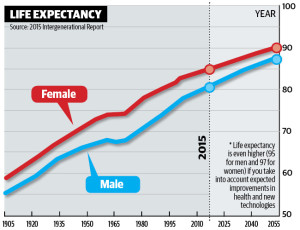The ‘grey army’ is a key to Australia’s future prosperity, according to Treasurer Joe Hockey. But what can the government do to increase participation of older people in the workforce? Its Restart program which offers employers $10,000 to hire an unemployed older person for two years has been a flop so far. Since last July, 956 people have benefited, the Employment Minister, Eric Abetz’s office told me. The program was expected to help up to 32,000 a year. Another program called Corporate Champions, aimed mainly at helping firms retain older workers, looks destined for the chop despite support in the business community. Corporate Champions was a Labor government initiative that was supposed to run for three years from 2013-2016. It’s proven so popular the allocated money has run out after a year, and no new companies can sign up.
Despite a surge in mature-age employment in the past 15 years, Australia has one of thelowest workforce participation rates for older people in the developed world. A higher proportion of older people is in work in New Zealand, the U.K, Sweden, Canada and the US. It’s relatively unusual to see someone of pension age strap-hanging on the bus in the morning peak hour. Can this be changed?
I think there’s no doubt Australia’s workplaces should harness the experience and wisdom of older people, and their contribution to the GDP. A lot of Australians can’t wait to retire; others want to work till they drop. A third group is in-between – they’d stay longer at work if more flexible work conditions were on offer. “Mature workers want to work longer but differently,” Alison Monroe, of Sageco, an employment consultancy, told me.
Many in this in-between group retire as soon as they can access their superannuation or the pension, or if other needs or desires pull them away. Because they want to pick up their grandkids from school a couple of days a week, or play golf on Fridays, they exit the workforce without exploring options. They assume bosses will be pleased to be rid of them.
That’s what Cynthia Cato 63 assumed when she resigned. She was in the young people’s business of advertising. She loved her job as a proof reader at the advertising agency. But she’d lost the affordable rented accommodation she’d enjoyed in Sydney for 30 years after the owner died. As a single woman, she couldn’t afford to buy near the city. But she could afford to buy in the countryside. She bought a beautiful cottage in rural Victoria, and she hoped she’d get a job packing shelves in a supermarket. “The managing director of the agency asked to see me. He said, ‘Cyndi, I’m not in the habit of letting good people go’ and so they worked out a deal,” Cynthia told me.
Cynthia now works from her rural Victorian home for the Sydney-based ad agency and couldn’t be happier. “If you have the internet, there’s no reason you can’t make a contribution to the workplace,” she said. “Older workers are prepared to give 110 per cent. We’re willing and reliable.”
The Corporate Champions program is geared mainly at this particular group – the workers who given flexibility could be persuaded to stay longer. Holding on to the existing mature-age workforce is where the big potential lies to increase participation. When the National Australia bank, one of the Corporate Champions, surveyed its mature-age workforce it found 91 per cent said they would work longer if they could work more flexibly; 62 per cent of staff leaders as a result of the program took steps to reduce barriers for older workers.
The Corporate Champions program has involved 486 big and small companies. Government funds don’t go to the companies but to approved providers who survey staff on retirement intentions, what it would take for them to work longer, and so on. Transition-to- retirement seminars in company time for workers have shocked some into knowledge of their true retirement financial position. The program appears to have been useful in educating both employees and employers. But last week’s Intergenerational Report mentioned only Restart as a government initiative for mature-age workers, signalling the possible end of Corporate Champions.
So many programs in this mature-age workers’ space have come and gone, from the “Wise Workforce” program of the Howard government to Labor’s Jobs Bonus. Many are not well thought-out or given a chance. Restart needs a bit of time to show it’s not a complete waste of money. And Corporate Champions should not be ditched just because it was a Labor initiative if it’s shown to change attitudes and practices.
More direct ways to keep older workers at the grindstone also need consideration. The most obvious is to raise the age at which superannuation can be accessed to the pension age. What’s your view of that? By 2023, the pension eligibility age will be 67 but access to super will be at age 60 (from 2024). Maintaining the gap provides a lure to the better-off to retire. Most importantly we need an economy that creates enough jobs for young and old. As for unemployed older people who are desperate to re-join a grey army of workers, they need a better deal. Higher penalties for age discrimination, and more naming and shaming of errant firms are needed to jolt employers and recruitment firms into changing their ways. The nicely, nicely approach hasn’t worked.
Source: Adele Horin blog
















